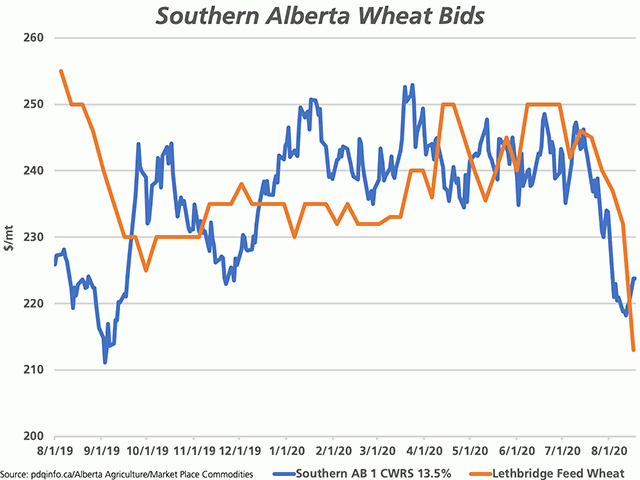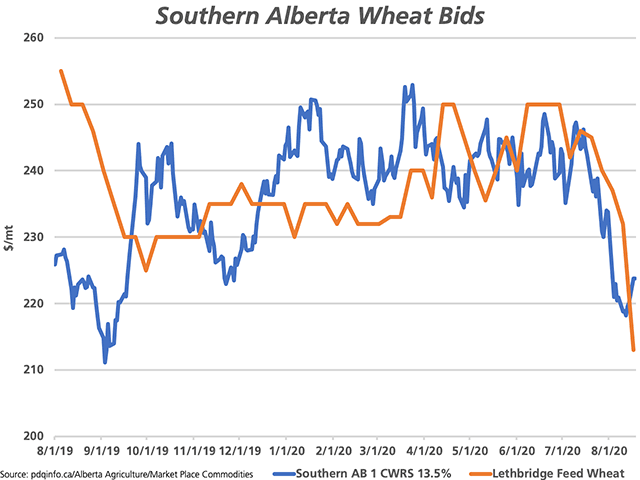Canada Markets
Prairie Spring Wheat Bids Show a Modest Recovery
While the North American spring wheat harvest is at an early stage, both futures and cash prices have shown a recent recovery. DTN analysis indicates a weak seasonal influence in spring wheat prices although there is a tendency for prices to peak in late May and bottom in late September. The seasonal chart would actually indicate this bottom may be found at the end of August or early September.
Amid a number of indications that bids for high protein spring wheat have fallen below feed prices on the prairies, we look at pdqinfo.ca bids reported over the past crop year and for the first weeks of 2020-21. Across the nine regions of the Prairies reported, cash bids hit lows ranging from $203.77/metric ton to $220.31/mt on Aug. 12. These lows were the lowest bids reported since late November for the two northern regions of Alberta, while were the lowest bids reported since mid-September 2019 for the seven remaining regions reported.
Since Aug. 12, gains across these nine regions have ranged from $5.53/mt to $7.25/mt, or 2.7% to 3.3%, respectively to a range from $210/mt to $227/mt. It is interesting to note that this strength has been achieved during a period of Canadian dollar strength, with the spot dollar closing above $0.76 CAD/USD on Aug. 18 and falling to $0.7581 CAD/USD on Aug. 19, still 35 basis points higher over the seven days.
The attached chart shows the milling wheat-feed relationship for spring wheat bids in southern Alberta over the past crop year. No. 1 CWRS 13.5% protein wheat has traded below feed prices on and off over the past crop year, which is based on the upper-end of the range of weekly prices reported for Lethbridge by Alberta Agriculture.
A sharp correction lower in feed prices, including barley delivered southern Alberta has led to feed wheat shown at $213/mt delivered southern Alberta as of Aug. 19, as reported by Market Place Commodities online recording.
P[L1] D[0x0] M[300x250] OOP[F] ADUNIT[] T[]
Global fundamentals for wheat remain bearish, with upward revisions made in Russia's production potential this week while recent DTN weather reports show favorable rains seen across many of Australia's wheat growing areas while precipitation is in the forecast for Argentina which is currently in need.
U.S. winter wheat harvest data is also showing improving protein levels. The latest U.S. Wheat Associates as of Aug. 14 has estimated the U.S. hard red winter wheat average protein at 12%, up from last year's final of 11.3% and the five-year average of 11.7%. While just two-thirds of the expected harvest samples have been graded, the recent trend has shown increasing higher protein.
At the same time, rains over areas of the northern states may have jeopardized spring wheat quality and remain supportive for this market.
In order to see how the markets have received this information, we look at the hard red spring/hard red winter price spread. As of Aug. 18, the spread in DTN's cash indices is seen at $0.62/bushel (bu), (HRS over HRW), below the $0.84/bu spread reported on the same date last crop year and the five-year average of $1.10/bu for this date.
When the two Dec. futures contracts are considered, this spread is calculated at 79.5 cents, below the $1.09/bu reported this time last year and the five-year average of 98 cents.
While CFTC statistics as of Aug. ll shows noncommercial traders building a larger and larger bearish net-short position, the HRS futures spreads show strength this week. This signals a less bearish/increasingly bullish approach by noncommercial/commercial traders. It is often the commercial side that pegs the market correctly, while this group has maintained a bullish net-long position for the majority of the time since June 2018.
**
DTN 360 Poll
This week's poll asks if you are concerned about the risks of COVID-19 as we move closer to harvest? You can weigh in with your thoughts on this poll, which is found on your DTN Home Page.
Cliff Jamieson can be reached at cliff.jamieson@dtn.com
Follow him on Twitter @Cliff Jamieson
© (c) Copyright 2020 DTN, LLC. All rights reserved.





Comments
To comment, please Log In or Join our Community .